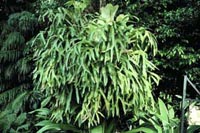Resource Library
Plant of the Week: Staghorn Fern
The University of Arkansas System Division of Agriculture does not promote, support or recommend plants featured in "Plant of the Week." Please consult your local Extension office for plants suitable for your region.
Plant of the Week
Staghorn Fern
Latin: Platycerium bifurcatum

Having just finished travel writer Bill Bryson's In a Sunburned Country, it's not surprising that perhaps the strangest of all ferns, the staghom fem, is native to Australia. Bryson, in fact most biologists, are constantly amazed by the biological diversity of this island continent. The staghom fern is just one of the botanical treasures Australia has given us.
Of the 17 species of staghom ferns ill the world, P. bifurcatum is the most widely planted because it can tolerate more abuse than the other more tropical species.
Staghom ferns have two very different kinds of leaves, or to be technically correct, fronds. The immature fronds are unlobed and kidney shaped. They fit together in a little dome that reminds me of a hubcap off of a late 50's Cadillac. You know, the ones with the big fins. These fronds start out green but eventually turn brown as the clump ages.
Beneath the protective cover of the sterile fronds are the roots that hold the plant to the tree on which it grows.
From these sterile fronds emerge fertile fronds that are unlike all other fern fronds. They have the general branching pattern of antlers, hence their common name, staghorn. The genus name "bifurcatum" means branched into two equally sized branches. Usually on these yard long fronds, each of the first branches will branch again. Sometimes this pattern will be repeated a third time, leaving a total of eight tips for the frond.
The leathery, gray-green fronds usually droop, forming graceful arching arms that are covered on the underside with a soft pubescence. When the season is right for spore formation, the tips of the fronds produce solid brown mats on the undersurface of the frond. Though I've tried several times, I have not been able to grow this plant from spores.
Staghorn ferns are native to eastern Australia. They range from the tropical forests of New Guinea to 3000-foot high Mount Boss in New South Wales, Australia. The staghom ferns from Mount Boss tolerate freezing temperatures as low as 10 degrees. The ferns in commerce today probably originated from more tropical parts of Australia and are not as cold hardy as these mountaintop inhabitants, but it does present an intriguing image of growing hardy staghom ferns out-of-doors.
Staghom ferns grow in nature as epiphytes. They use trees for support, but don't actually obtain any nourishment from the trees. At first glance, it might appear that being glommed onto the side of the tree would be a very inhospitable location for a fern, but in reality tree trunks are aerial streams by which water passes to the ground. Areas where the staghorn grows often receive more than 120 inches of rainfall a year.
Growing staghorn ferns is relatively easy because they tolerate conditions inside our homes quite well. They are best located in a bright location with relatively high humidity. They are perhaps best in the bathroom, above the kitchen sink or similar locations. In the summer they benefit from being moved to the shaded patio.
When division time comes, use a long knife to cut the sterile, hubcap-shaped frond that has a new plantlet appearing free. They may be attached by wire to a slab of osmunda fiber, or they can be planted in a hanging basket filled with coarse bark.
Do not pot staghom ferns in a medium that holds too much water or the roots will rot. Fertilize the plants once a month during the summer by pouring a little diluted fertilizer into the crown of the plant.
By: Gerald Klingaman, retired
Extension Horticulturist - Ornamentals
Extension News - February 2, 2001
The University of Arkansas System Division of Agriculture does not maintain lists of retail outlets where these plants can be purchased. Please check your local nursery or other retail outlets to ask about the availability of these plants for your growing area.